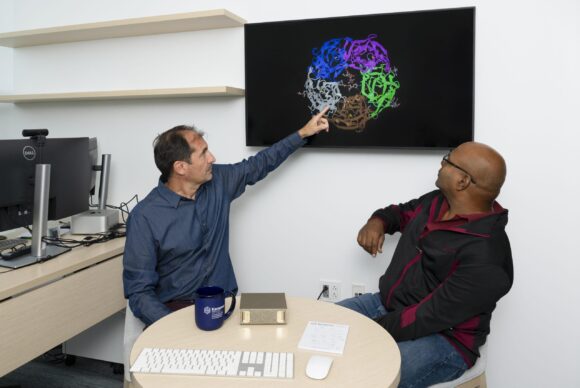Decoding Epilepsy with the Power of AI
Harvard researchers harness the power of a new desktop supercomputer to map the genetics of brain function

Kempner Co-Director Bernardo Sabatini (left) and Kempner Senior AI Computing Engineer Bala Desinghu (right) use a new desktop supercomputer to study how disruptions to neurons in the brain can drive neurological disorders such as epilepsy.
Photo: Anna Olivella
The Kempner Institute for the Study of Natural and Artificial Intelligence has launched an ambitious new project that brings together the frontiers of biology and computing to uncover how genetic mutations in the brain give rise to epilepsy.
At the core of the project is a fusion of powerful tools. Scientists are combining a pioneering genetic technique developed at Harvard Medical School with a compact desktop supercomputer, giving experimental biologists access to a new computational tool for conducting research that reduces the need for access to massive computing centers. The result: a more efficient workflow where complex analyses can unfold in real time—right at the researchers’ desks.
A New Window into the Brain
The immediate focus of the project is epilepsy, a disorder marked by seizures caused by overactivity of brain circuits. The research team, led by Bernardo Sabatini, co-director of the Kempner Institute and Alice and Rodman W. Moorhead III Professor of Neurobiology at Harvard Medical School, in collaboration with the lab of Dr. Beth Stevens at Boston Children’s Hospital, has recently developed a transformative technique that allows researchers to introduce a different single genetic mutation into thousands of individual cells in the brain.
This precise manipulation provides an unprecedented opportunity to study in parallel how each of many individual mutations affects the function of specific neurons. By selectively introducing mutations into different types of neurons, the researchers can test how these changes alter cellular activity.
“We introduce these mutations to different kinds of neurons under the hypothesis that they’ll make some neurons more active and other neurons less active,” explains Sabatini.
Understanding how certain mutations cause neurons to become hyperactive is critical to explaining why seizures occur.
The Puzzle of Inhibitory Neurons in Epilepsy
The brain’s neurons generally fall into two categories: excitatory and inhibitory. Excitatory neurons increase the activity of other neurons, while inhibitory neurons suppress it. Seizures are thought to emerge when this delicate balance is disrupted and brain circuits become overactive.
Yet mutations in inhibitory neurons often present a paradox. Some mutations in inhibitory neurons actually enhance a neuron’s ability to inhibit others, a phenomenon known as “gain of function.” As Sabatini puts it: “You’d think that would make the brain less active, right?” But in many cases, the opposite occurs: gain of function in inhibitory neurons co-occurs with overactivity in brain circuits. “We need a combination of experimental data and simulations to resolve this counterintuitive phenomenon.”
Sabatini and his team are studying roughly 6,000 mutations in excitatory and inhibitory neurons, focusing on how these genetic changes affect protein structure and function in each cell type. Genes encode proteins, which form the molecular machinery of cells, and mutations can alter a protein’s structure in ways that disrupt—or in some cases enhance—its function. Understanding these changes is central to explaining how genetic variation can drive neurological disorders such as epilepsy.
Modeling Proteins at Scale
This is where desktop supercomputing comes in. Sabatini and his team are now using the NVIDIA DGX Spark, a new desktop supercomputer, to simulate the effects of the thousands of mutations that they are also studying experimentally. To do this, they are analyzing mutations using a powerful protein structure prediction model called Boltz-2, which can run on the desktop supercomputer.
“We’re hoping that by computationally analyzing all 6,000 mutants at the same time that we analyze them experimentally, we’ll be able to make a prediction map,” says Sabatini. Such a map would help identify which mutations are most likely to produce meaningful changes in neuronal function, allowing the researchers to focus experimental efforts where they matter most.
Protein structure prediction is notoriously computationally intensive, requiring vast amounts of processing power. Sabatini and his team will leverage the desktop supercomputer in the early stages of research, where repeated rounds of testing and refinement are necessary.
A New Computational Paradigm
The Kempner Institute is one of the first academic institutions to have access to the DGX Spark—a box about the size of a Mac Mini that is capable of computing at rapid speeds up to one petaFLOP. For Sabatini, the machine offers a way to test how experimental biologists can integrate supercomputing directly into their everyday workflow without needing to access a supercomputing cluster, such as the Kempner AI cluster, in order to test new ideas, write new code, and iterate on experiments.
“We’re asking whether a person in a biology lab can use a workhorse on their desk,” said Sabatini, “where they can do this kind of analysis in a weekend without all the infrastructure that a cluster provides.”
In many ways, the desktop supercomputer functions as a testing ground, allowing Sabatini and his team to see what works and what doesn’t, and use preliminary results to inform larger-scale, more resource-intensive projects on the Kempner AI cluster.
The Sabatini lab has been using the DGX Spark to successfully screen for mutations in small test proteins, getting a sense of how long each screen takes. Now, with that data in hand, the team is scaling up its mutation screening, using the desktop supercomputer to look for mutations in an inhibitory receptor protein within brain cells.
“If we can get this to work on one GPU, we can then launch 100 GPUs to test 100 proteins in a few days, and have a comprehensive map,” Sabatini says. This integration of desktop-scale and cluster-scale computing is already accelerating research cycles and may serve as a model for more efficient research in many domains.
Beyond Epilepsy: Toward a Science of Intelligence
The implications of Sabatini’s current project using desktop supercomputing extends well beyond epilepsy. By charting how mutations shape the proteins that govern neuronal function, researchers are uncovering the fundamental rules by which diverse cell types form circuits and process information.
“One of our goals is to understand how diverse cell types in the brain form complex circuits that perform computation,” says Sabatini. “So this is our first step towards trying to understand the fundamental building blocks of each one of those cells.”
By connecting the molecular biology of neurons to the computational frameworks of artificial intelligence, Sabatini and his team are pushing the frontiers of both neuroscience and machine learning. The hope is that these insights will help transform how we understand the brain and neurobiological disease, and at the same time inspire new approaches to building the next generation of intelligent machines.






